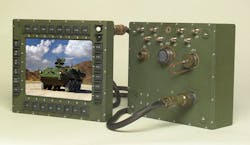Army looking for COTS dumb terminals to upgrade obsolescent rugged displays in Stryker vetronics
WARREN, Mich. — U.S. Army vetronics experts are looking for rugged dumb terminals — video displays without internal processors — to replace obsolescent displays in the Army’s fleet of Stryker Double V-Hull A1 (DVH A1) armored combat vehicles.
Officials of the Army Contracting Command in Warren, Mich., have issued a request for information (W56HZV-19-Vehicle-Electronics-and-Architecture-Request-for-Information) to find commercial off-the-shelf (COTS) solutions for DVH A1 in-vehicle network-2 (IVN-2) mission display.
The Army Contracting Command is issuing this RFI on behalf of the Vehicle Electronics and Architecture office of the Army Tank and Automotive Research, Development, and Engineering Center (TARDEC) in Warren, Mich.
The Army is looking for rugged displays without processors to replace obsolescent displays in the Stryker armored combat vehicle.
Army vetronics designers are looking for stand-alone dumb displays to replace the Stryker DVH A1 video display terminal (VDT) and its replacement video display electronic terminal (VDET), which rapidly are approaching obsolescence, Army officials say.
The new display’s USB touchscreen and USB bezel may be provided to the keyboard, video, mouse (KVM) through one interface, and the displays should be able to accommodate secure classification separation. The new display’s performance should be equal to or better than the current VDET specification.
The rugged displays must have active touchscreen areas of at least 10 inches. The complete display and bezel must not be larger than 12.25 by 11 by 4.25 inches, and weigh no more than 24 pounds. Its bezel buttons must use the USB human interface device (HID) keyboard protocol, and use either the USB HID touchscreen; USB HID touchpad; or USB HID mouse protocol.
If companies would like to suggest a smart display, its processor must be physically removable from the unit at its point of manufacture to help the Army avoid removing the processor later on.
Army officials want to know the availability and cost of providing a display without an internal processor in a production quantity of 300 units per year; and to understand risk areas that could inhibit product development.
The Army only wants display hardware that meets the Stryker Mission Display (SMD) performance specification, which is available for download as a Microsoft Word document at https://www.fbo.gov/utils/view?id=cb6f4457b2ddb812eafe28dae2bee0ea.
Companies interested were asked to email responses to the Army’s Jenelle Vickberg at [email protected] no later than 18 Feb. 2019. Email questions or concerns to Vickberg at [email protected].
More information is online at https://www.fbo.gov/notices/ab233684b4f2e814712e1a15cf738afb.

